Klipsch R-600F
Product Name: Klipsch R-600F
Product Description: Floorstanding Loudspeaker
-
Design - 9.2/10
9.2/10
-
Movies Performance - 9/10
9/10
-
Music Performance - 9/10
9/10
-
Inputs and Features - 9.1/10
9.1/10
-
Price / Quality - 9.4/10
9.4/10
Summary
Reviewed at $999.00 (pair)
Pros
- Nice detailed sound
- Energetic high end
- Good quality cabinet
- Meaningful upgrade over previous Reference series
Cons
- A bit bright output
- Not the most neutral of speakers
- Vintage look is not for everyone
- Cannot use spikes
Cheapest Places to Buy :
*We are a reader-supported website. When you buy through links on our site, we may earn a small affiliate commission at no extra cost to you. Home Media Entertainment does not accept money for reviews.*
Introduction
If there is one brand that needs no introduction in the home theater arena that is definitely Klipsch. Their speakers are a fan favorite for both cinephiles and audiophiles for many years now, offering both low cost and more expensive solutions for everyone to choose from. And so today, in our Klipsch R-600F review, we have the pleasure of testing one of their latest floorstanders and determine if they are worthy of the name Klipsch on them.

The Klipsch R-600F is part of their new Reference series which became available in 2022. The new series includes a total of 12 different speakers. There are 3 floorstanders, 4 bookshelf speakers, 2 center speakers, 1 surround speaker and 2 subwoofers. The sheer amount of options obviously is perfect in order to shape your setup anyway you desire.
But let’s see real quick what the smaller of the floorstanders is all about. The Klipsch R-600F is a 2-way floorstanding speaker that continues the legacy of the previous Reference series. This speaker comes with dual 6.5″ woofers along with a single 1″ aluminum tweeter in what is by now the signature of all Klipsch speakers. A 90 x 90 square Tractrix Horn.
Klipsch surely made some very obvious changes in the new Reference series compared to the previous one. Surely, with all budget friendly speakers some corners need to be cut. But are these enough to jeopardize what we know by now to be Klipsch’s characteristic sound? Keep reading to find out.
Design, Inputs and Features
Exterior design & Dimensions
As always we will start with the design. Although the new Reference series keeps this vintage feeling that all Klipsch speakers are famous for, it does have some differences compared to the previous release. And upon further inspection we can say with certainty that most of them are in the right direction.
As for its size, we measured the R-600F to be 40” x 9.4” x 15.2” (1017 mm x 240 mm x 386 mm) and with a weight of 41 lbs (18.6 kg) each.
As always, with Klipsch’s characteristic looks, you will either love them or hate them. And the new R-600F is no different. Unfortunately for one more time you get only one color, and that is no other than Black vinyl. Klipsch never offered multiple colors in their speakers so no real surprise here.
Cabinet
The cabinet of the new R-600F is using a 3/4″ MDF material, as per usual with many speakers of this type. But with this new version Klipsch went ahead and improved both the interior and exterior construction.
In the interior Klipsch enhanced the cabinet’s bracing. This resulted in reduced resonances and less vibrations. On the outside the obvious changes are the new Tractrix horns that now extend edge-to-edge. And also the hidden woofer fasteners for a cleaner and more seamless look.
Although the cabinet is made out of MDF, Klipsch used a very nice scratch-resistant, textured wood grain vinyl. This can fool most people for being real wood and shows the amount of work they did to make them as good looking as possible.
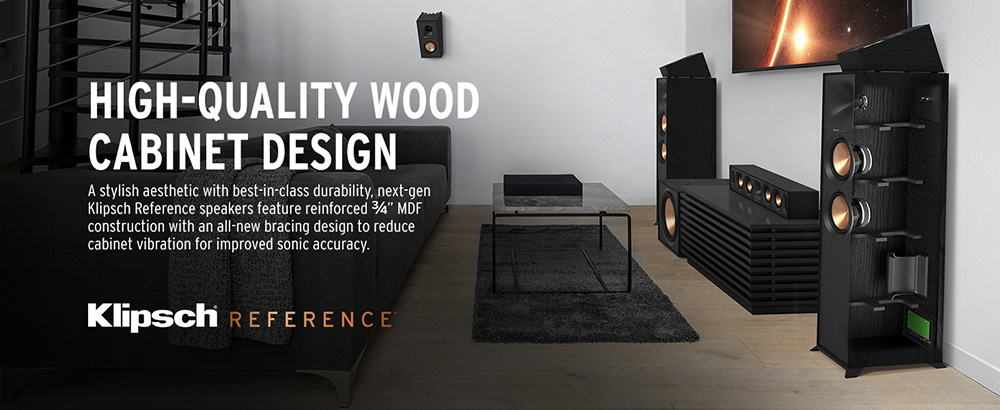
Rear Tractrix Ports
The R-600F come with a single rear facing Tractrix port in the lower part of the speaker, just above the binding posts. Klipsch specially designed this port in order to create ideal airflow with minimal distortion or turbulence even at the lowest frequencies.
As always having speakers with rear air ports means you need to be extra careful with placement. As the low end output can vastly change depending how close to the walls you place them.
Grilles
The grilles that come with the R-600F are made of a black colored cloth and cover the entire front baffle. Obviously this is a personal choice. But it is really a shame to have such nice speakers and have the grilles cover these beautiful woofers.
We love that Klipsch made these magnetically attached. Because usually in this price range most speakers go for grilles with plugs. Which certainly do not look so good in comparison.
Stand
The R-600F comes with cast aluminum feet and provide a more modern look with less resonance than MDF or ABS plastic. It is mechanically designed to minimize surface area in contact with floor, decoupling the speaker for faster, tighter low frequencies and more detail.
But this design also has a few drawbacks. First of all you cannot adjust the stand for uneven surfaces. Which can be a bit of a problem if you have a carpet and the speakers will have to sit on the edge of it. Also with such a design you obviously cannot use spikes with all the problems this may have.
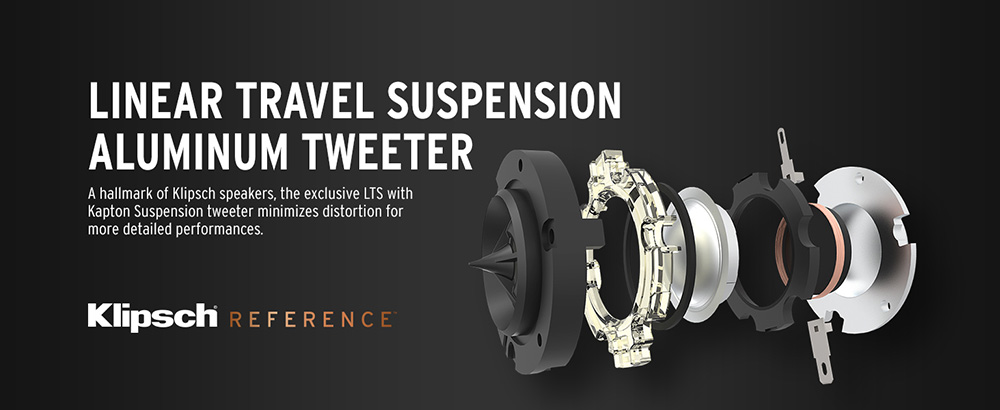
Drivers Design
But the changes in the new Reference series do not end with the cabinet. Klipsch also made some drastic changes on the woofers and drivers used.
The Klipsch R-600F is basically a 2-way design. At the top we find a single 1″ aluminum LTS tweeter mated to a 90 x 90 square Tractrix Horn while below them we get two 6.5″ spun-copper TCP woofers.
LTS tweeter
First of all, for the high frequencies Klipsch used a 1” aluminum LTS tweeter with Kapton suspension. Aluminum is an extremely light and rigid material used in the tweeter assembly to provide high efficiency.
The exclusive Linear Travel Suspension (LTS) minimizes distortion for enhanced, detailed performance. LTS tweeters are a hallmark of previous Reference lines, making it a core component of some of the best speakers in the world.
This unique tweeter design allows for proper interaction with Klipsch’s proprietary Tractrix Horn technology. Horn loading maximizes efficiently and increases detail while focusing high frequencies towards the listening area. Proprietary Tractrix geometry provides the most efficient transfer of high frequency waves into the listening area.
In the new R-600F the horn’s dimensions have increased. With its edge-to-edge design Klipsch tried to improve high frequency directivity, create a more accurate soundstage and a larger sweet spot in the listening space.

TCP Woofers
Moving on to the woofers next. The R-600F use dual 6.5″ spun-copper TCP woofers. TCP is a new material in the 2022 Reference series and stands for Thermoformed Crystalline Polymer. The copper plating is what gives these woofers their unique color that all Klipsch woofers are famous of.
But its not only the material that is interesting in these new woofers. Taking notes from the Reference Premiere series, the cones have a steeper angling which makes them have smoother response, as this design improves cone break up (i.e., resonances) at higher frequencies. They also allow for better crossover integration for improved accuracy and transparency.
Additional ribs help with increased rigidity as they do not allow the cones to deform as much.
Drivers Specifications
The combination of the 1″ aluminum LTS tweeter with the 6.5″ spun-copper TCP woofers give the R-600F the following characteristics. A frequency response of 38Hz – 21kHz (+/- 3dB), 8 ohms of impedance and 96 dB sensitivity.
The crossover frequency between the tweeter and the woofers is set at 1,440Hz. The speakers come with a rating of 100 watts continuous and 400 watts of peak power.
Connectivity
The R-600F use single gold plated binding posts which are located at the lower part of the back face. With the available terminals you can either use bare wires or various plugs including spades or banana plugs if that is your preference. And here we find another change in the design of the new Reference series floorstanders.
The speakers come with a second set of binding posts. But you cannot bi-amp or bi-wire them to an amplifier or AV receiver. Instead these can be used in case you want to add the R-40SA Dolby Atmos modules on top of them. In that case you don’t have to run the cables all the way up to them.
Instead you can connect the Atmos channel cables to the lower back of the R-600F. And connect the Dolby Atmos modules to the additional connectors that are placed on the upper part of the back face. This way you have much better cable management and a vastly cleaner look.
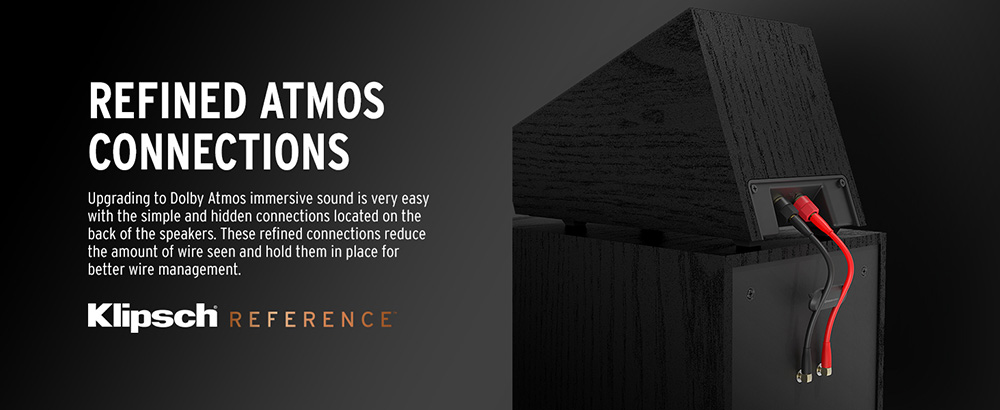
Positioning & Setup
Unpacking of the R-600F was not hard at all and with a little care you can do it all by yourself. Klipsch took extra care of the packaging and everything is secure and safe inside the box.
Along with the speakers you get the usual manuals and the stands that need to be attached at the bottom of each cabinet. The whole process is easy but you need to be delicate not to damage them during assembly.
Placement
In the manual Klipsch includes instructions about setting them up and preferred distances. Specifically they suggest about 6 to 15 feet (1.8 to 4.6m) between them. Your sitting position should be 1 to 1.5 times the distance separating the speakers.
Obviously these are general guidelines and give you an idea of normal positioning. But as always you need to experiment to find how they sound best to you and make changes accordingly.
For this review we left around 2 feet from the back wall in order to give them slightly more breathing space. Keep in mind that placing the speakers near a wall will increase their bass output. But this will be at the cost of overall definition so finding the best balance is always crucial. And with the R-600F being rear ported, placement near a wall can change the sound output to a certain degree.
Distance between the two speakers was, as usual, around 9 feet. We also like to toe-in them a little towards our viewing position for better sound imaging.
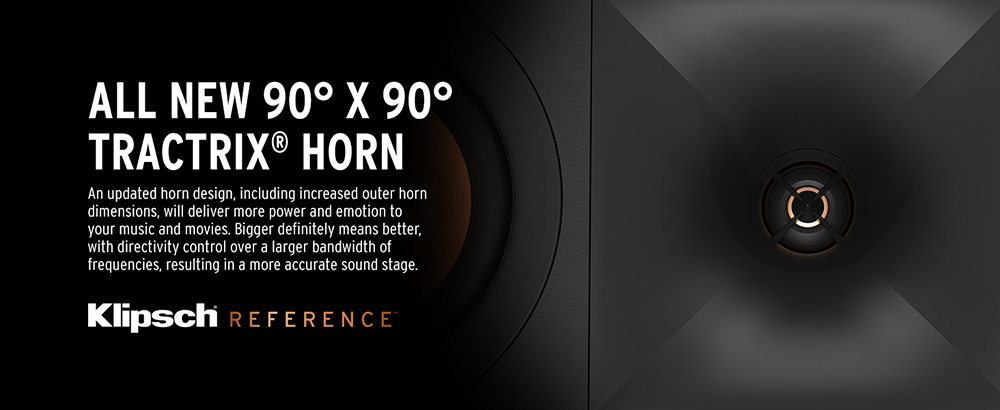
Running Hours
The R-600F we got for testing, we were told, were past their brake-in period. So in theory they could reach their peak performance.
Most manufacturers do suggest to give them certain time in order to get the best out of them. This usually comes at about 100 hours on average for most brands. But each one gives slightly different numbers that’s why we do suggest 100 hours, to be on the safe side.
There is one last thing to mention here. In our movies testing we tend to strictly use a 4.0 channels surround system. A full surround system can sometimes cover some weaknesses many speakers have.
But with our half baked system it is easier to determine how they can perform. Obviously if you add a subwoofer along with a center speaker the overall immersion will increase tenfold. So keep this in mind when you read our reviews.
As for our music testing we always switch to a standard 2.0 channels audio setup that most audiophiles tend to go with. Obviously since we are more into movies we will use an AV receiver instead of separates. But as you can imagine a dedicated music setup will do even better in this regard.
So without further delay, and after finishing the necessary audio calibrations with our Marantz AV receiver, we moved on with our tests.
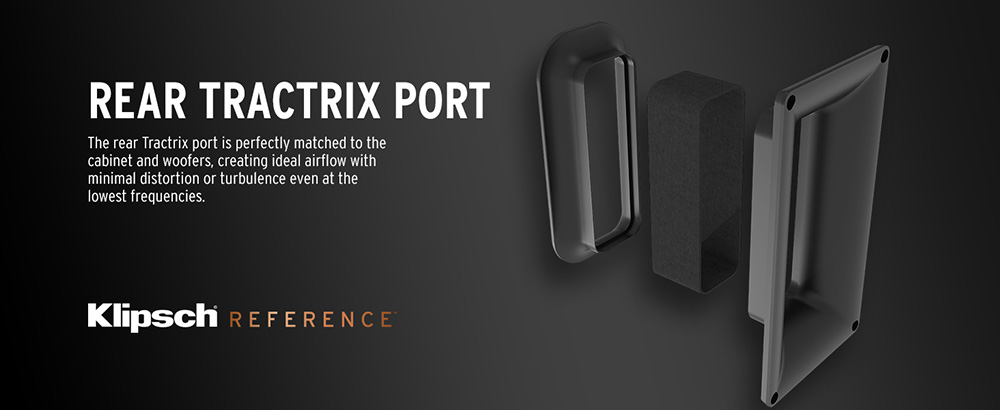
Movies
Lord of the Rings : The Fellowship of the Ring
What better way to try out the R-600F than using our 4K UHD copy of Lord of the Rings: the Fellowship of the Ring which comes with a truly astonishing Dolby Atmos mix.
We have tried this film in many of our reviews and usually when you have seen the same scenes so many times you usually know what to expect. The Klipsch R-600F managed to give us a slightly different output, that is characteristic of most horn based systems. It is not a completely different performance, but Klipsch speakers do tend to give a bit more bright high end.
Even though this is supposed to be Klipsch’s low budget series, the R-600F showcased remarkable handling of the entire frequency range. Their ability to provide a lot of subtle details the mix had was another characteristic we noticed in many of the scenes we checked.
The Mines of Moria for example was a scene worth seeing. As the company was traveling in complete silence and darkness, the R-600F would render even minor environmental and ambient sounds that most of the time go unnoticed.
The front sound wall was every bit as dynamic and powerful as you should expect from a floorstander of this caliber. The mid-range was solid and created the perfect foundation for both edges of the frequency range to nicely bind with the rest.
Dialogue was clear and distinct. And even though we didn’t use a center speaker all voices were nicely isolated at the center. We would like to feel a bit more depth to the sound but in general what we heard was more than satisfactory. And we are sure that most home theater setups will have a dedicated center speaker, so this is not much of a problem really.
The 6.5″ woofers can provide a low end punch when needed but obviously in very demanding scenes they do show their limitations. When Balrog makes his appearance his footsteps and growl felt slightly weak. But it’s nothing a dedicated subwoofer cannot fix.
The Klipsch speakers managed to fill our testing area evenly, creating a really immersive atmosphere. They give enough attention to details, they are bold and powerful and they have all the characteristics you should expect to hear from a horn based speaker.
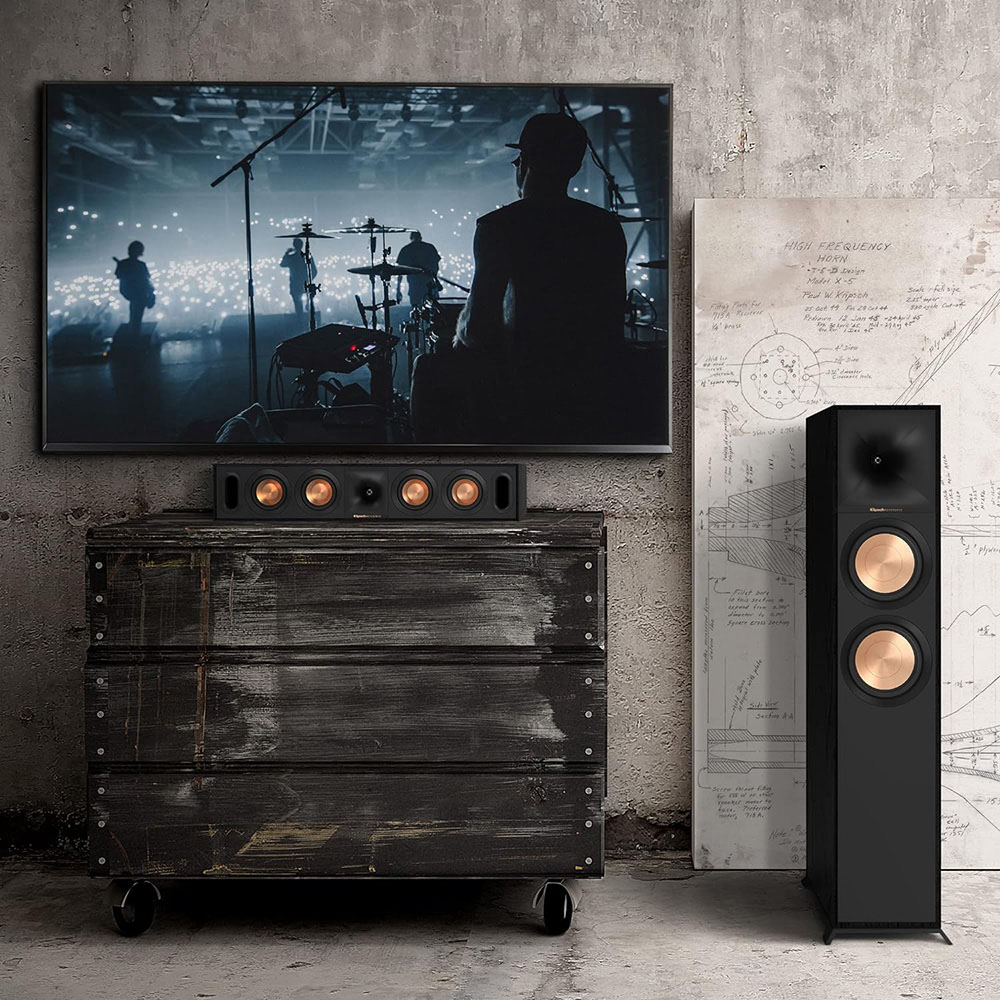
300
Next we switch gears to something with a bit more action so we picked 300 in its 4K UHD format for some bombastic Dolby Atmos action.
This film is a sonic attack to the ears, with its stylized combat and action sequences and the Klipsch speakers were like a happy child in a candy store. The vast majority of the film is accompanied by an amazing soundtrack while environmental and surround effects kept hitting us from all directions.
This mix does not care so much about subtleties. It will grab you by the hair and keep slapping you in the face, scene after scene. The R-600F managed again to give us a noteworthy performance. With each slow motion battle scene the Klipsch speakers recreated the brutality of war in such a visceral and powerful way.
At no moment did we thought about the low cost nature of the R-600F, as they rendered everything with precision and clarity. Dialog felt slightly less distinct but again, without a center channel, we were pretty happy with how all voices would still originate from the center.
300 is a film that has plenty of low end activity. The R-600F did a valiant effort to push the low end, and to a certain degree they did alright. You could sense where their limits are and plenty of moments we wished to be able to get more out of it. But again you need to know what to expect from them in this regard. The mid-range/bass woofers did a really good job and we cannot complain much about them.
Closing Remarks
The price of the Klipsch R-600F is as good as it gets for a good quality floorstander speaker. Yes obviously you will not get the extreme high fidelity of other premium HiFi speakers but you have to take into consideration their price also.
The second thing you need to think of, is the performance of the R-600F as a horn based speaker. Usually you will either love or hate it and they tend to go a bit overboard at the top end, which many users don’t like much.
But if you do like how a horn based speaker sounds, and you are on the lookout for a low cost set of floorstanders, then the Klipsch R-600F should definitely be on your consideration list.
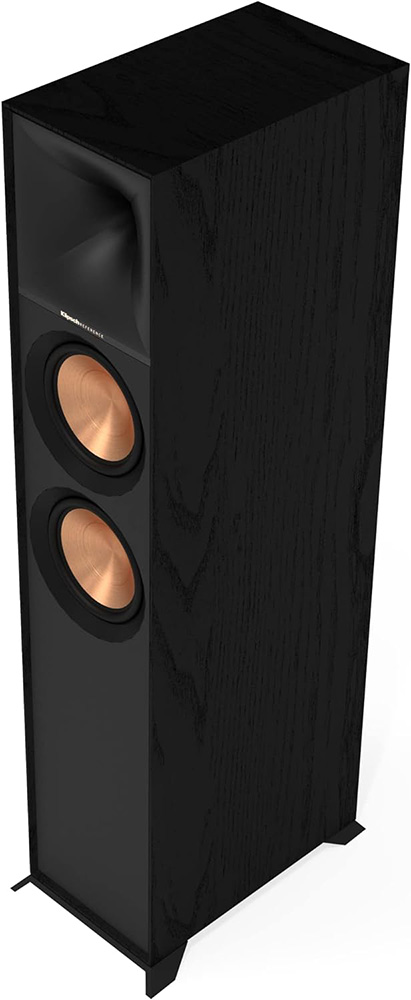
Music
Next, we switched to a pure 2.0 channels audio setup with only the two front speakers connected and we streamed a selection of FLAC music tracks through the front USB port of our Marantz receiver.
Fidelity & Overall Quality
Obviously, with movies many of the more subtle details get lost in the maelstrom of cinematic action. But with music the speakers do show off what they are really capable of.
The speakers know how to be cozy when the performance asks for it. But they will have no problem reveal their bright nature when they are asked of it.
Either you are into analog or digital recordings, these speakers can really bring forth all the qualities of each song. Some minor details may sound simplified, something you should expect due to their low budget nature. But overall you are not going to be disappointed by their lively and rich output.
Sound imaging was really good but not the best we have heard in this category. There was enough expansion and directionality to the sound but they did miss some finer details from time to time. But this is mostly nitpicking and we never considered this a real problem that could jeopardize their overall output.
Bass
The low end was satisfactory to a certain degree, but with some extremely bass intensive performances the speakers felt like they had reached their limits. If you are not particularly demanding in this area the R-600F will suffice. Otherwise we suggest you to consider the bigger floorstander of the series. With its 8″ woofers you are going to get a much better bass output.

Different Content
As usual, we tried a few different genres to see how the speakers behave. The horn based output of the Klipsch R-600F do favor certain genres more than others. But in general we found their output to be stellar across the board.
Either you like rock, jazz or electronic the Klipsch can play them all with enough fidelity, good attention to details and minimal distortion.
Final Thoughts
Klipsch is a brand that everyone knows or at least have heard of. Their speakers have gained the respect of both casual and advanced users around the world for a reason. They are just damn good. And the Klipsch R-600F very well continue this trend to this day.
The R-600F have everything you should expect from a low cost but good quality speaker. The cabinet is meticulously crafted and upgraded over the previous series. And its sound output is every bit as good as any Klipsch speaker came before it. It has the characteristic punchy high end that many horn based speakers are known for. But it also manages to bring forth a lot of details and subtleties of each performance that you usually hear in more expensive speakers.
Do they have any drawbacks? Obviously for this price you cannot expect the ultimate audiophile performance. If you like a more neutral and linear output you may find the R-600F a bit more intrusive. And obviously you will have to like the vintage color scheme that all Klipsch speakers come with. There is only a single color to choose from. And lastly placing them on uneven surfaces may be a bit problematic as they do not accept spikes.
We reached the end of our Klipsch R-600F review and to be honest we are happy with everything Klipsch did in their latest series. All changes and upgrades were in the right direction and the speakers proved to be an excellent choice for anyone looking for an affordable floorstander that has the quality and performance of more expensive offerings.
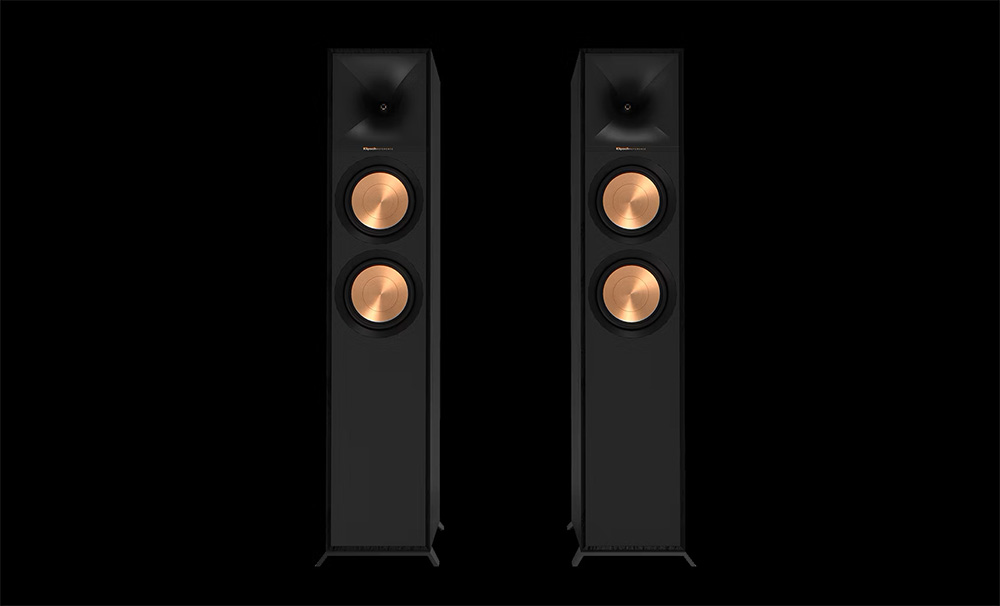
For more reviews you can check our dedicated Floorstanding Speaker reviews list or even look at our Product Reviews Table where you can find the brand and specific product you are looking for.
Cheapest Places to Buy :
*We are a reader-supported website. When you buy through links on our site, we may earn a small affiliate commission at no extra cost to you. Home Media Entertainment does not accept money for reviews.*





I see that they make some special discounts on these speakers now. You can even get them for $299 each! This is crazy even for a low budget Klipsch speaker! I have some Klipsch bookshelves in the past and they were wonderful. But as always they do sound a bit bright. So you really have to like this type of sound to really appreciate them.
Hello Marko. Indeed, every horn based speaker is similar. They do have a characteristic output so I always recommend a test hearing because these are not for everyone.
Great read on the Klipsch R-600F! I love the looks of the dual 6.5″ woofers and the 1″ aluminum tweeter combo. How do you think these speakers would fare in a smaller room, considering their rear port design? Looking to upgrade my setup, and your reviews are steering me in the right direction. Cheers!
Hey Ryan. Although I do not know your room design, the smaller the room the more pronounced the bass will be if you place them closer to a wall. How small of a room are we talking about here? Because if it is too small maybe some bookshelf speakers would fare better in your situation.